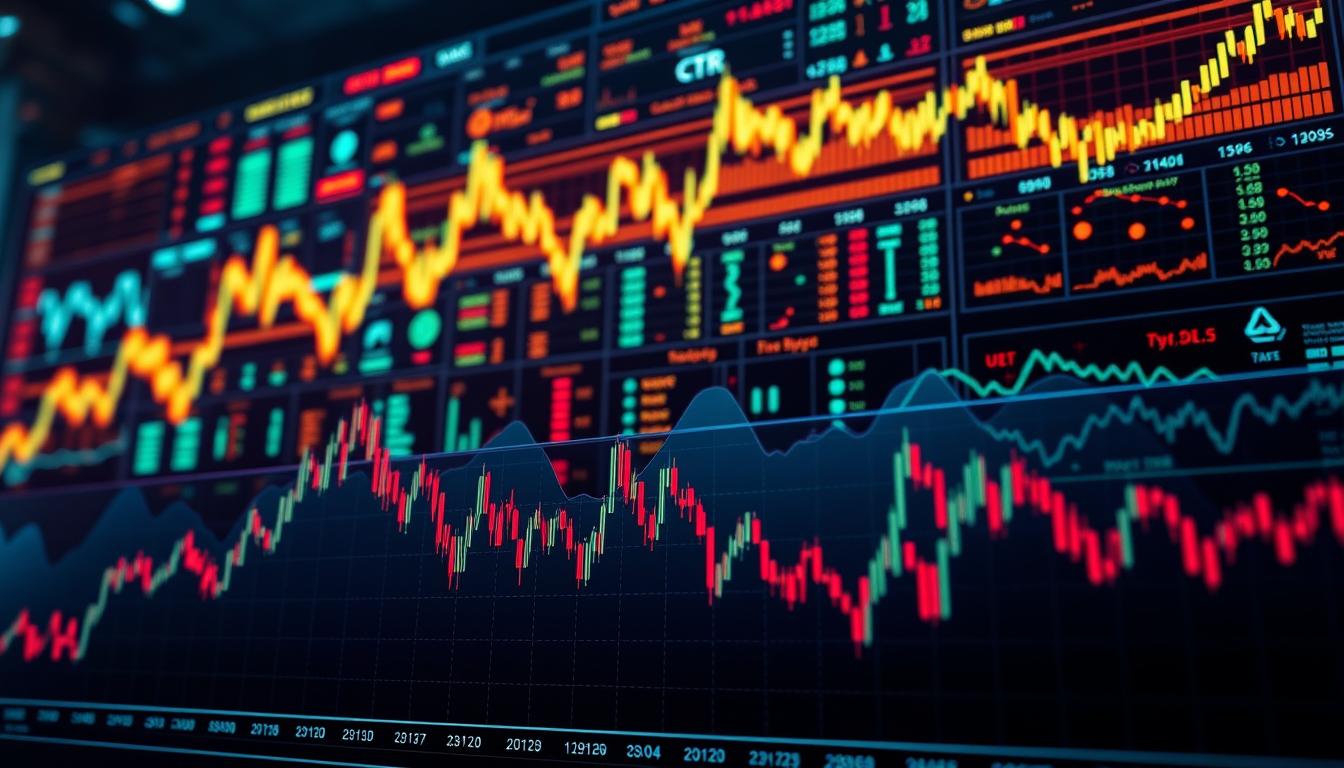Now Reading: Cryptocurrency Market Volatility Analysis Patterns Guide
- 01
Cryptocurrency Market Volatility Analysis Patterns Guide
Cryptocurrency Market Volatility Analysis Patterns Guide

Navigating the dynamic world of cryptocurrency market volatility requires sophisticated analysis and strategic understanding. Investors and traders face unprecedented challenges in deciphering complex market movements that define digital asset trading. Cryptocurrency market volatility represents a critical factor influencing investment decisions and trading strategies across global financial platforms.
Mastering market analysis patterns provides traders with essential tools to understand price fluctuations, risk management, and potential profit opportunities. This comprehensive guide explores intricate techniques for interpreting cryptocurrency market volatility, empowering investors to make informed decisions in an increasingly unpredictable digital asset landscape.
From fundamental technical indicators to advanced trading methodologies, our exploration will unlock crucial insights into cryptocurrency market dynamics. Traders will gain practical knowledge about recognizing market trends, understanding sentiment shifts, and developing robust trading strategies that adapt to rapid market changes.
Key Takeaways
- Understand cryptocurrency market volatility fundamentals
- Learn advanced market analysis pattern techniques
- Develop strategic trading approaches
- Recognize critical market sentiment indicators
- Implement risk management strategies
Understanding the Fundamentals of Crypto Market Volatility
Cryptocurrency markets represent a dynamic financial landscape characterized by rapid crypto price fluctuations and complex market behaviors. Investors and traders must develop a deep understanding of the underlying mechanisms driving these dramatic price movements.
The cryptocurrency ecosystem experiences unique volatility patterns that distinguish it from traditional financial markets. These fluctuations stem from multiple interconnected factors that create a complex and unpredictable trading environment.
Key Drivers of Price Fluctuations
Several critical elements contribute to cryptocurrency market volatility:
- Regulatory announcements and government policies
- Technological innovations and blockchain developments
- Macroeconomic global trends
- Institutional investment movements
Historical Volatility Trends in Major Cryptocurrencies
Analyzing historical volatility reveals significant insights into cryptocurrency market behavior. Bitcoin and Ethereum demonstrate distinctive price movement patterns that reflect their unique market dynamics.
| Cryptocurrency | Average Annual Volatility | Price Range Variation |
|---|---|---|
| Bitcoin | 65% | ±$10,000 |
| Ethereum | 55% | ±$500 |
Impact of Market Sentiment on Price Movement
Market sentiment plays a crucial role in driving crypto price fluctuations. Social media platforms, news outlets, and influential industry figures can dramatically shift investor perception, triggering significant price movements within minutes.
Understanding these fundamental dynamics helps investors navigate the complex and volatile cryptocurrency landscape with greater confidence and strategic insight.
Essential Tools for Analyzing Crypto Market Movements
Navigating the complex world of cryptocurrency requires sophisticated crypto analysis tools that help traders and investors make informed decisions. These market movement indicators provide critical insights into the dynamic digital asset landscape, empowering users to track real-time market data with precision.
Professional traders rely on several key platforms to monitor cryptocurrency markets effectively:
- TradingView – A robust charting platform with advanced technical analysis features
- CoinMarketCap – Comprehensive cryptocurrency price tracking and market data
- Glassnode – Advanced on-chain analytics for deeper market understanding
- CryptoCompare – Real-time price and trading volume aggregation
When selecting crypto analysis tools, investors should consider multiple factors such as data accuracy, real-time updates, and comprehensive market movement indicators. Each platform offers unique strengths that can help decode market trends and potential trading opportunities.
The most effective approach involves combining multiple tools to create a holistic view of market conditions. Professional traders typically use a mix of technical analysis platforms, on-chain data aggregators, and sentiment analysis tools to develop comprehensive trading strategies.
- Compare price movements across different exchanges
- Track historical volatility patterns
- Analyze trading volume and liquidity
- Monitor market sentiment indicators
By leveraging these sophisticated crypto analysis tools, investors can gain a competitive edge in the rapidly evolving cryptocurrency market, transforming complex data into actionable trading insights.
Technical Analysis Indicators for Volatility Measurement
Cryptocurrency traders rely on sophisticated technical analysis indicators to navigate the complex and dynamic market landscape. Understanding these tools can provide crucial insights into price movements, market sentiment, and potential trading opportunities.
Effective technical analysis indicators help traders predict market volatility and make informed decisions. These powerful tools transform raw market data into actionable trading strategies.
Bollinger Bands: Measuring Market Volatility
Bollinger Bands are a critical technical analysis indicator for measuring cryptocurrency price volatility. These bands consist of three lines:
- A middle simple moving average
- An upper band (typically two standard deviations above the middle line)
- A lower band (two standard deviations below the middle line)
RSI and MACD: Advanced Trading Signals
Two essential technical analysis indicators for cryptocurrency traders are the Relative Strength Index (RSI) and Moving Average Convergence Divergence (MACD):
- RSI helps identify overbought or oversold market conditions
- MACD reveals trend momentum and potential trend reversals
Volume Profile Analysis Methods
Volume profile analysis provides deep insights into market structure by visualizing trading activity at different price levels. This technique helps traders understand:
- Key support and resistance zones
- Potential price rejection areas
- Market participant behavior
Market Psychology and Trading Behavior Patterns

Cryptocurrency trading involves complex psychological dynamics that significantly impact market movements. The crypto market psychology reveals how emotions drive investor decisions, often creating unpredictable trading behavior that can amplify market volatility.
Key psychological factors influencing investor sentiment include:
- Fear of Missing Out (FOMO) – driving impulsive buying during price surges
- Panic selling during market downturns
- Herd mentality in cryptocurrency investment
- Confirmation bias in trading decisions
Traders frequently experience emotional triggers that challenge rational decision-making. Understanding these psychological patterns can help investors develop more disciplined trading strategies.
Crypto market psychology demonstrates that investor sentiment can create significant price fluctuations. Emotional reactions often lead to:
- Overreaction to market news
- Irrational buying during market peaks
- Sudden mass sell-offs triggered by collective fear
Successful cryptocurrency traders learn to recognize and manage these psychological patterns, transforming emotional impulses into calculated investment approaches.
Cryptocurrency Market Volatility Analysis Patterns
Navigating the complex world of cryptocurrency trading requires a deep understanding of market dynamics and key analytical patterns. Successful traders develop keen insights into market movements by recognizing critical indicators that signal potential shifts in market trends.
Identifying market conditions becomes crucial when analyzing cryptocurrency volatility. Traders rely on specific bull market indicators and bear market indicators to make informed investment decisions.
Bull and Bear Market Indicators
Market sentiment plays a pivotal role in cryptocurrency trading. Key indicators help traders distinguish between bullish and bearish market conditions:
- Sustained price increases above moving averages
- High trading volume during price movements
- Relative strength index (RSI) momentum
- Market capitalization trends
Support and Resistance Level Recognition
Understanding support and resistance levels provides critical insights into potential price movements. Traders use these levels to identify potential entry and exit points, helping them make strategic trading decisions.
- Identify historical price zones
- Analyze multiple timeframe charts
- Track volume at key price levels
Trend Reversal Signals
Detecting potential trend reversals requires careful analysis of multiple indicators. Traders watch for specific patterns that suggest a potential shift in market direction, helping them anticipate significant market movements.
- Divergence between price and technical indicators
- Candlestick pattern formations
- Breakdown of key support or resistance levels
Risk Management Strategies for Volatile Markets

Navigating the cryptocurrency market requires robust crypto risk management techniques. Successful traders understand that protecting capital is as crucial as generating profits. Volatility trading strategies demand a disciplined approach to minimize potential losses.
Effective risk management begins with comprehensive planning. Investors should develop a strategic framework that addresses several key components:
- Position sizing to limit exposure
- Implementing strict stop-loss orders
- Diversifying cryptocurrency portfolio
- Understanding risk-reward ratios
Position sizing remains a critical element of crypto risk management. Traders should never risk more than 1-2% of their total portfolio on a single trade. This approach helps protect against significant losses during unexpected market fluctuations.
Stop-loss orders provide an essential safety mechanism in volatile trading environments. These automated orders trigger a sell action when a cryptocurrency drops to a predetermined price, preventing catastrophic financial losses.
Diversification stands as another powerful volatility trading strategy. By spreading investments across multiple cryptocurrencies and asset classes, traders can mitigate risk and reduce overall portfolio vulnerability.
Risk-reward ratios help traders make calculated decisions. A standard recommendation is maintaining a minimum 1:3 ratio, meaning potential gains should be at least three times the potential loss on any given trade.
Time-Based Analysis of Crypto Market Cycles
Understanding the temporal dynamics of cryptocurrency markets is crucial for successful trading strategies. Crypto market cycles reveal intricate patterns that can help investors navigate the complex digital asset landscape. By examining different time frames, traders can gain valuable insights into market behavior and potential price movements.
Analyzing crypto market cycles involves multiple perspectives across various time horizons. Investors must develop a comprehensive approach to interpreting market dynamics and recognizing potential trend shifts.
Daily Trading Patterns
Daily trading patterns provide critical short-term insights into cryptocurrency market behavior. Traders typically observe several key characteristics:
- Intraday volatility trends
- Trading volume fluctuations
- Price movement correlations with global market sessions
- Immediate market sentiment indicators
Weekly and Monthly Trend Analysis
Expanding beyond daily observations, weekly and monthly trends offer deeper perspectives on crypto market cycles. These longer-term analyses help investors understand broader market movements and potential trend directions.
- Weekly trends reveal intermediate market momentum
- Monthly trends highlight significant price trajectories
- Long-term pattern recognition strategies
Seasonal Market Behaviors
Seasonal crypto patterns demonstrate unique characteristics that can significantly impact trading strategies. Some notable seasonal behaviors include potential year-end rallies and summer market lulls, which sophisticated investors carefully monitor.
By integrating time-based analysis across daily, weekly, and monthly perspectives, traders can develop more nuanced approaches to navigating cryptocurrency market volatility.
Impact of Global Events on Crypto Volatility

Cryptocurrency markets are deeply sensitive to global events, with geopolitical factors creating significant waves of volatility. Investors and traders must understand how external influences can dramatically shift crypto valuations within minutes.
Several key global events can trigger substantial crypto market impact:
- Major economic policy changes
- International political tensions
- Regulatory announcements from significant financial jurisdictions
- Technological breakthrough developments
Financial experts recognize that cryptocurrencies represent a unique asset class vulnerable to rapid sentiment shifts. Geopolitical factors like trade conflicts, sanctions, or unexpected governmental regulations can cause immediate price fluctuations across digital currency markets.
Recent examples demonstrate the profound connection between global events and cryptocurrency performance. The Russia-Ukraine conflict, COVID-19 pandemic, and US-China trade tensions have all produced measurable impacts on digital asset valuations.
Successful crypto investors develop strategies to monitor and anticipate potential market-moving events. This requires consistent tracking of international news, understanding interconnected global financial systems, and maintaining flexible investment approaches.
- Track international financial news sources
- Understand cross-border economic relationships
- Develop risk management protocols
- Maintain diversified investment portfolios
By comprehending the intricate relationship between global events and cryptocurrency markets, investors can make more informed decisions during periods of heightened volatility.
Advanced Chart Pattern Recognition
Cryptocurrency traders rely on sophisticated chart pattern recognition to navigate volatile markets. Understanding formation patterns provides crucial insights into potential price movements and trading opportunities.
Chart pattern recognition involves identifying visual representations of market psychology and potential trend shifts. Traders use these patterns to anticipate future price actions with greater precision.
Identifying Complex Formation Patterns
Successful chart pattern recognition requires deep analytical skills and technical understanding. Key formation patterns traders should master include:
- Head and shoulders pattern
- Double top and bottom formations
- Triangular consolidation patterns
- Ascending and descending wedges
Breakout and Breakdown Analysis Techniques
Breakout analysis helps traders identify potential trend reversals and significant market movements. Professionals use multiple confirmation signals to validate potential breakouts, including:
- Increased trading volume
- Sustained price movement beyond key resistance/support levels
- Complementary technical indicator signals
- Confirmation from multiple timeframe analyses
Effective breakdown analysis requires careful assessment of market structure, trading volumes, and underlying cryptocurrency market dynamics. Traders must develop sophisticated strategies that integrate comprehensive chart pattern recognition with robust risk management techniques.
Volatility-Based Trading Strategies
Cryptocurrency markets present unique opportunities for traders who understand volatility trading. Successful crypto trading strategies require a deep comprehension of market dynamics and the ability to exploit market volatility effectively.
Traders can leverage several key approaches to capitalize on market fluctuations:
- Momentum Trading: Ride price trends by identifying strong market movements
- Range Trading: Capitalize on price oscillations between defined support and resistance levels
- Breakout Trading: Enter positions when price breaks critical market thresholds
Effective market volatility exploitation demands sophisticated analytical skills. Traders must develop robust strategies that adapt to rapidly changing market conditions.
| Strategy | Risk Level | Potential Return |
|---|---|---|
| Momentum Trading | High | Significant |
| Range Trading | Medium | Moderate |
| Breakout Trading | High | High |
Successful crypto trading strategies require continuous refinement. Backtesting and analyzing historical market data are crucial for developing reliable volatility trading approaches that can withstand market unpredictability.
Institutional Trading Effects on Market Movement
The cryptocurrency market experiences significant transformations through institutional crypto trading. Large-scale investors and financial institutions wield substantial influence over digital asset price dynamics, creating ripple effects that individual traders must understand.
Institutional involvement in cryptocurrency markets has grown exponentially, bringing sophisticated trading strategies and substantial capital. These players can trigger massive market movements through strategic transactions and long-term investment approaches.
Whale Activity Monitoring
Tracking whale activity represents a critical strategy for understanding market sentiment and potential price shifts. Cryptocurrency whales—investors holding large token quantities—can dramatically impact market trends through their trading decisions.
- Analyze wallet balances of top cryptocurrency holders
- Monitor large transaction volumes exceeding $1 million
- Track wallet movements across different exchanges
- Utilize blockchain explorers for real-time tracking
Exchange Flow Analysis
Exchange flow analysis provides deep insights into cryptocurrency market dynamics. By examining inflows and outflows from major trading platforms, investors can gauge potential market trends and sentiment shifts.
- Evaluate net cryptocurrency deposits and withdrawals
- Identify significant institutional transfer patterns
- Understand market liquidity through exchange movements
- Detect potential price manipulation signals
Sophisticated investors leverage these analytical techniques to make informed trading decisions, transforming raw data into actionable market intelligence.
Cross-Market Correlation Analysis

Understanding crypto market correlations provides traders with powerful insights into inter-market analysis. Asset correlation represents a critical strategy for managing investment risk and identifying potential trading opportunities across different financial markets.
Cryptocurrency markets demonstrate complex relationships with traditional financial assets. Investors can leverage these correlations to:
- Predict potential market movements
- Develop sophisticated risk management strategies
- Identify emerging investment opportunities
- Understand interconnected market dynamics
Traders performing inter-market analysis typically examine relationships between:
- Major cryptocurrencies like Bitcoin and Ethereum
- Traditional stock market indices
- Commodities such as gold
- Foreign exchange markets
Advanced correlation analysis tools help investors track real-time market dependencies. These sophisticated techniques enable traders to detect subtle shifts in market sentiment and anticipate potential price movements across different asset classes.
Successful crypto market correlation strategies require continuous monitoring, advanced analytical tools, and a deep understanding of global financial ecosystems. Investors who master these techniques can develop more resilient and adaptive investment approaches.
Developing a Volatility Trading Plan
Crafting a robust volatility trading plan is crucial for cryptocurrency traders navigating unpredictable market conditions. Successful traders understand that a well-structured approach can transform market uncertainty into strategic opportunity.
A comprehensive volatility trading plan requires careful consideration of multiple critical components that work together to manage risk and maximize potential returns.
Position Sizing Techniques
Effective position sizing is the cornerstone of risk management in volatile cryptocurrency markets. Traders should implement strategic approaches to protect their capital while maintaining potential for growth.
- Utilize percentage-based risk allocation (1-2% per trade)
- Adjust position sizes based on market volatility indicators
- Implement dynamic sizing methods that respond to market conditions
Entry and Exit Strategies
Developing clear entry and exit strategies helps traders maintain discipline and reduce emotional decision-making during intense market fluctuations.
- Define precise entry points using technical analysis
- Set predetermined stop-loss levels
- Create trailing stop mechanisms to protect gains
Successful volatility trading plans require continuous refinement. Traders should regularly review their strategies, analyzing performance metrics and adapting to evolving market dynamics.
Leveraging Market Data Analytics
Crypto market data analytics has transformed how traders approach the volatile cryptocurrency landscape. Data-driven decisions are now crucial for navigating the complex digital asset ecosystem. Professional traders leverage sophisticated trading algorithms to extract meaningful insights from massive datasets.
Key components of effective crypto market data analytics include:
- On-chain transaction metrics
- Social sentiment indicators
- Order book depth analysis
- Historical price pattern recognition
Modern trading strategies rely on advanced data collection techniques. Algorithmic trading platforms can process thousands of data points per second, identifying potential market opportunities faster than traditional manual analysis methods.
Successful cryptocurrency traders understand that raw data must be transformed into actionable intelligence. By implementing robust data analytics frameworks, investors can:
- Minimize risk exposure
- Identify emerging market trends
- Optimize trading entry and exit points
- Develop predictive trading models
The future of cryptocurrency trading lies in sophisticated data analytics tools that provide comprehensive market insights. Traders who embrace data-driven decision-making will likely outperform those relying on intuition or outdated analysis techniques.
Real-Time Market Monitoring Systems
Successful cryptocurrency traders recognize the critical importance of real-time crypto monitoring in navigating volatile markets. Advanced trading dashboards provide traders with instantaneous insights into market movements, enabling rapid decision-making and strategic positioning. Platforms like TradingView and CoinGlass offer comprehensive market analysis tools that help investors track critical price fluctuations and volume changes.
Market alerts represent a powerful mechanism for staying informed about significant cryptocurrency market shifts. Sophisticated mobile applications now allow traders to customize notifications for specific price thresholds, sudden volume spikes, and potential trend reversals. These real-time crypto monitoring systems eliminate the need for constant screen watching, empowering investors to make informed decisions without being tethered to their trading terminals.
Effective trading dashboards integrate multiple data streams, presenting complex market information in intuitive visual formats. Traders can configure personalized interfaces that highlight key performance indicators, historical trends, and emerging patterns. By filtering excessive market noise and focusing on actionable intelligence, investors can develop a strategic approach to cryptocurrency trading that minimizes emotional decision-making and maximizes potential returns.
Professional traders understand that successful market monitoring goes beyond simple data collection. It requires a disciplined approach to interpreting market signals, understanding technological trends, and maintaining a clear strategic vision. With the right tools and mindset, investors can transform real-time data into a competitive advantage in the dynamic world of cryptocurrency trading.
FAQ
What is cryptocurrency market volatility?
Cryptocurrency market volatility refers to the rapid and significant price fluctuations that occur in digital currency markets. It represents the rate at which the price of a cryptocurrency can increase or decrease within a specific time frame, often characterized by dramatic and unpredictable price swings.
How do global events impact cryptocurrency volatility?
Global events can dramatically influence cryptocurrency markets through various channels, including regulatory announcements, geopolitical tensions, economic policy changes, and major technological breakthroughs. These events can trigger immediate and substantial price movements, making the crypto market particularly sensitive to external factors.
What are the key tools for analyzing crypto market movements?
Essential tools for analyzing cryptocurrency market movements include data aggregators, advanced charting platforms, real-time price tracking systems, technical analysis indicators like Bollinger Bands and RSI, and comprehensive analytics platforms that provide on-chain metrics and trading volume insights.
How can traders manage risk in volatile cryptocurrency markets?
Risk management in volatile crypto markets involves strategies such as proper position sizing, implementing stop-loss orders, diversifying investment portfolio, setting clear entry and exit points, using risk-reward ratios, and maintaining a disciplined approach to trading that isn’t driven by emotional responses.
What role does market psychology play in cryptocurrency trading?
Market psychology significantly influences cryptocurrency trading, with behavioral patterns like FOMO (Fear of Missing Out), panic selling, and herd mentality driving market movements. Understanding these psychological triggers can help traders make more rational decisions and avoid common emotional trading mistakes.
How do institutional traders impact cryptocurrency markets?
Institutional traders, often referred to as “whales,” can cause substantial market movements through large-scale transactions. Their activities can influence market sentiment, trigger price shifts, and create significant volatility through massive buy or sell orders that can quickly change market dynamics.
What are the most important technical indicators for measuring crypto market volatility?
Key technical indicators for measuring cryptocurrency market volatility include Bollinger Bands (for identifying price ranges), Relative Strength Index (RSI), Moving Average Convergence Divergence (MACD), Volume Profile Analysis, and various trend recognition tools that help traders understand potential market movements.
Can cryptocurrency volatility be predicted?
While complete prediction is impossible, traders can anticipate potential volatility by analyzing historical price patterns, monitoring market sentiment, tracking global events, studying technical indicators, and using advanced analytical tools to identify potential market trends and potential price movements.
What is the importance of cross-market correlation in cryptocurrency trading?
Cross-market correlation helps traders understand relationships between different cryptocurrencies and traditional financial markets. By analyzing these connections, traders can identify potential trading opportunities, manage risk more effectively, and develop more comprehensive trading strategies that account for broader market dynamics.
How frequently do cryptocurrency markets experience significant volatility?
Cryptocurrency markets are known for frequent and rapid volatility, with significant price movements potentially occurring multiple times within a single day. This high-volatility environment distinguishes crypto markets from traditional financial markets and requires traders to maintain constant vigilance and adaptive strategies.













